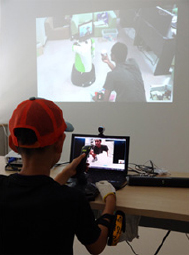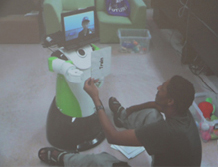This project explores the use of child-operated telepresence robot for the purpose of facilitating international communication between distant classrooms. In particular, we developed user interfaces that enabled young children three years old could remotely control his/her avatar robot that was placed in a remote location.


Most importantly, it was revealed that children who could not communicate well with speakers of different languages over conventional video conference services could communicate using the telepresence robot system developed by this project. This was because even the situation in which they could not communicate verbally due to the language difference, on this system they could use their bodily movements such as gestures, physical object-handling, etc., which in fact mattered significantly. We investigated these aspects and reported a strong potential for remote education.
We also conducted an international field trial that connected remote classrooms between Australia and Japan.

- Fumihide Tanaka, Toshimitsu Takahashi, Shizuko Matsuzoe, Nao Tazawa, and Masahiko Morita: Telepresence Robot Helps Children in Communicating with Teachers who Speak a Different Language, Proceedings of the 2014 ACM/IEEE International Conference on Human-Robot Interaction (HRI 2014), pp.399-406, Bielefeld, Germany, March 2014 [free pdf available at ACM DL here, 1.1MB]
- Fumihide Tanaka, Toshimitsu Takahashi, Shizuko Matsuzoe, Nao Tazawa, and Masahiko Morita: Child-Operated Telepresence Robot: a Field Trial Connecting Classrooms between Australia and Japan, Proceedings of IEEE/RSJ International Conference on Intelligent Robots and Systems (IROS 2013), pp.5896-5901, Tokyo, Japan, November 2013 [pdf, 1.6MB, IEEE Xplore]
- Fumihide Tanaka, Toshimitsu Takahashi, Masahiko Morita: Tricycle-style Operation Interface for Children to Control a Telepresence Robot, Advanced Robotics, Vol.27(17), pp.1375-1384, 2013 [draft pdf, 1.3MB] [published version, 938KB]
(Updated on June 27, 2019)
